The Perfect Nintendo Theme Park
By jbn566 0 Comments
My thoughts regarding the perfect Nintendo Theme Park
http://www.degreesofwhimsy.com/the-perfect-nintendo-theme-park/
My thoughts regarding the perfect Nintendo Theme Park
http://www.degreesofwhimsy.com/the-perfect-nintendo-theme-park/
I have started up my in depth look at the History of Baseball Video Games again. This time over at my website - Degrees of Whimsy
http://www.degreesofwhimsy.com/?p=1332
This is a series of blogs based on my own personal game collection. I will attempt to go through them in a chronological order according to their release date. I will also attempt to play then on their original platform using the original controllers the game was designed for. If I am unable to get the system or the game working then I will use PC emulation or another platform emulation like the Intellivision Lives! game for the gamecube
Previous entries
9. Sega Master System's Great Baseball (1987) 10. Nintendo's Bases Loaded (1987) 11. Nintendo's R.B.I Baseball (1988) 12. Nintendo's Major League Baseball (1988) 13. Sega Master System's Reggie Jackson Baseball (1988) 14. TurboGrafx 16's World Class Baseball (1989) 15. Nintendo's Tecmo Baseball (1989) |
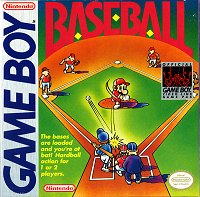
In the late 80’s Nintendo wasn’t happy with controlling the market share of the TV screen, they wanted to control the pocket. Nintendo created a mobile NES that anyone can hold and carry around with them, The system was call Game Boy and become one of the greatest systems every sold and released. With a new system out on the market, a new baseball would have to be released to make it a true success. Nintendo’s Gameboy game, Baseball, is not the first portable baseball game on this list but it is the first portable game where you play both sides of the sport. Microvision’s Baseball in 1983 was more or less a home run derby type game.
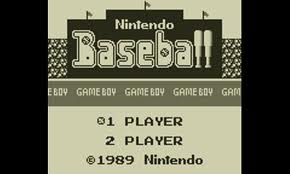
While it is not the first true portable baseball game based on the definition of the words it is the first to have a true video screen with graphics. The screen might be small and might be limited to only one color; the graphics are really not bad. Baseball takes its visual cue from more of the RBI baseball than the NES’s Baseball game. The pitching is behind the batter and the camera is closer to the field requiring scrolling when the ball is in the air. The pitcher and batter’s name is displayed during the pitch; the B/S/O is readable, using dots to represent the count I always prefer as I feel glancing at dots doesn’t force me to read text.
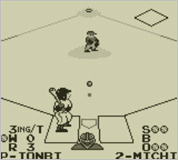
The field contains the basic of fields and everything normally found on the field including the foul lines, and batter's box. The system didn't support color so the field was more of the lack of color. The lines formed the field and defined the infield and outfield. The outfield contained a wall that displays the words 'Nintendo' on the center field much like the NES Baseball.
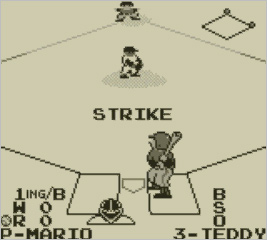
This is where the RBI baseball influence is shown the greatest. The batters and pitchers have that ‘round’ look to them. The batter’s helmet is detailed and has a shine to it along with an ear hole. Because the game boy lacked color the uniforms all look the same, one team just had a darker shirt. The batter’s pants contains a pinstripe down the side but because all the batter’s look the same makes it a generic experience. The catcher’s back is cut off and you only see the back of his mask and shoulders.
There is no in game scoreboard during end of the innings. The only scoreboard that is displayed is on the title screen
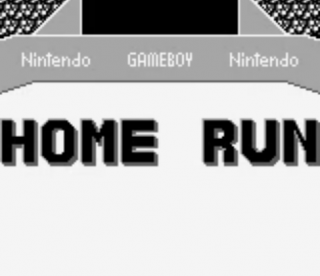
The celebration is pretty basic as well but a celebration does exist nevertheless. Once the ball lands in the stands, Big letters that stretch the width of the screen scrolls from the bottom to the center that spell ‘Home Run’ as well as nice melody.
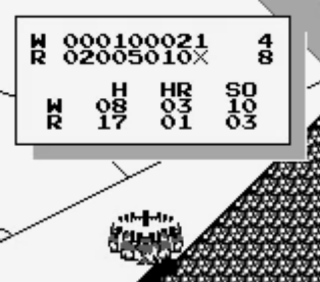
There are two cameras in use during the game. Behind the batter’s view during the pitches and another bird’s eye camera that follows the ball as it travels through the infield and outfield. There is a PnP of the infield at all times that helps see where the base runners are at the same time.
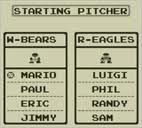
The menus are simple and easy to read. There is a menu to select which team you want to play and the pitcher. You can pitch hit as well as bring in a relief pitcher which displays a basic popup with a bare min information about the player
The background music is very catchy. It doesn’t make wish I had my ipod. There is no umpire voice or play by play. The sound effects such as the crowd, ball flying through the air is standard for typical baseball video games. The crowd noise is radio static and the ball flying through the air is a slide whistle.
There is only 2 modes for this game; 1 or 2 player single nine inning baseball game. Once you select the number of players you are able to select ‘USA mode’ or ‘JPN mode’ The only thing I can tell is the difference between these two modes is the names of the players on the team.
The game boy only has two buttons and not a whole lot of options. You control the fielder that is closest to the ball and you throw it to the bases to attempt to throw the runner out. The fielders in the game are wearing the same slow shoes as many game prior. I feel it takes forever to get to the ball. The throw isn’t very speedy either. The defense isn’t bad and doesn’t ruin the enjoyment of the game. You are able to move the pitcher and change direction of the pitch which provides a great deal of flexibility. Striking out the CPU was not impossible and a great feeling
The batter can move around in the batter’s box which is always helpful to make contact with the ball. Base running is standard as well. Nothing really innovated regarding the offense.

The game includes the 10 run mercy rule which exists in the little leagues but does not in MLB. Each team field 9 players and you are able to select the starting pitcher as well as pitch hit. There has yet been a game in this series where you can pitch run a base runner and I didn’t expect this game to advance the sport all the much. True fully the fact that I able to play a baseball video game in the car was all the rules I needed.
When you finish the game, a nice animation of the pitcher being lifted up and down is a nice effect as well as displays a game summary full of stats such as hits, home runs, and strike outs
This is a series of blogs based on my own personal game collection. I will attempt to go through them in a chronological order according to their release date. I will also attempt to play then on their original platform using the original controllers the game was designed for. If I am unable to get the system or the game working then I will use PC emulation or another platform emulation like the Intellivision Lives! game for the gamecube
Previous entries
9. Sega Master System's Great Baseball (1987) 10. Nintendo's Bases Loaded (1987) 11. Nintendo's R.B.I Baseball (1988) 12. Nintendo's Major League Baseball (1988) 13. Sega Master System's Reggie Jackson Baseball (1988) 14. TurboGrafx 16's World Class Baseball (1989) |

After the introduction of a 16-bit baseball game in the previous blog, there is still a lot of 8-bit games still being developed and released. 1989 through 1992 were transitional years for the industry where developers produced games for old systems with established installed base andwell as produce games for the sexy, state of the art platforms such as the TurboGrafx-16. Tecmo Baseball was released only on the Nintendo Entertainment System in 1989. Tecmo was a popular sports video game development house, most famous for the Tecmo Bowl football game. Is there a reason why Tecmo Baseball isn’t on the same level? Let’s find out.
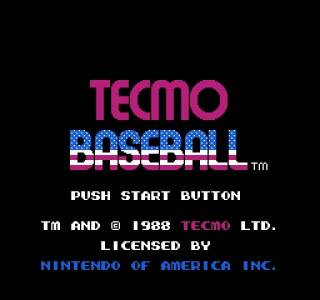
I will be honest, maybe it is because I have been playing a lot of NES baseball games as of late, but this game comes across as very generic. It almost appears as though the development team took what they thought was great about the previous released baseball games and put them into this game. There are elements of Bases Loaded, Baseball and RBI Baseball. Overall the graphics and presentation is not really bad just felt as though I have seen and played this game before.
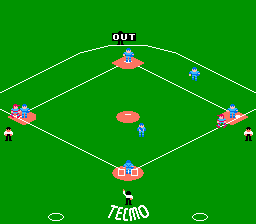
We are back in the 8-bit world so we lose textures and forced to play on solid green fields. Once again we have a baseball game where the infield dirt is only around the bases and not part of the base paths. There is no first base running path line and the bases and home plate are displayed correctly. The pitcher’s mound doesn’t appear to have height to it. Tecmo is great at inserting their own name into their games. One such way was including their name on the green grass directly behind home plate for the field camera as well as on the back stop wall for the behind the pitcher view. No matter which camera is showing the game, the words ‘Tecmo’ is there to help remind you what game you are playing.
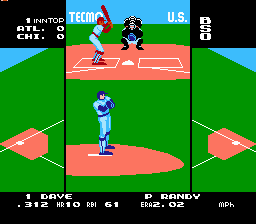
During the behind the pitcher view the players look really stiff, the players are lean and not chubby like R.B.I Baseball and looks like a slightly enhanced version of Bases Loaded. The batter and pitcher have eyes on their faces as well as stirrups but their feet are huge; I am talking clown shoe size. Because of the behind the pitcher view the pitcher is larger and closer to the camera and thus more detail has been applied to them. There is actually some shadowing effects going on with the pitcher’s uniform. There also lacks numbers on the uniforms which adds to the feeling of generic fielders and base runners.
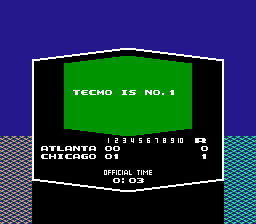
Did I mention the word ‘generic’ in the blog yet. If not then let me reserve that word to describe the scoreboard. I don’t really understand this scoreboard; there is a huge green jumbotron that appears to a waste of space majority of the time. In-between the innings the jumbotron shows random sayings and sentences that doesn’t seem to be based on anything. Examples of things that might appear in the center of the jumbotron is ‘Big Hit’, ‘Tecmo is number 1’, ‘Fight’. Besides the green jumbotron the scoreboard did include the scoring summary per inning. It lacked stats such as hit count, errors as well as the lineup.
I am not even going to detail the crowd in this game. They literally took the 1983 baseball game and copied the pattern. It’s ugly.
Now here is where I can see the influence of Bases Loaded in the game. This game took the home run animation of Bases Loaded and applied minor, very minor changes to it. In Bases loaded the batter is displayed on the scoreboard’s jumbotron rounding 2 base in the background as the pitcher is kneeling down in disgust. This game the camera is reversed and the batter is in the foreground with the pitcher behind him. When the batter approaches the dugout he high fives his teammates the same way Bases Loaded animated it.
| Tecmo Baseball | Bases Loaded |
|---|---|
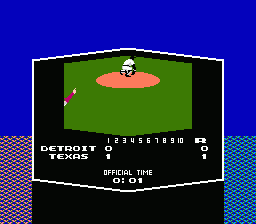 | 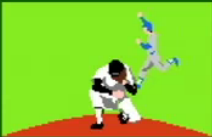 |

The screen during the pitching was influenced by R.B.I baseball; 1 base and 3 base camera is always displayed and takes up 1/3 of the screen each. The main camera is behind the pitcher unlike RBI’s behind the batter view. This setup was weird for me because while there was a camera on 1 and 3, if there was a runner on second you can just see the back of their uniform poking out from the bottom of the screen. You couldn’t see 2 base and hard to gauge how far off the base they are standing to pick them off. The fielding camera did contain an overhead view of the diamond and I felt like I would like to see that during the pitching. The main camera did display the pitcher and batter’s name and stats such as ERA, home run and RBI count as well as batting average.
There is no editing of the lineup and roster in the game so the use of menu is less important. During pitch hitting and calling for a relief pitcher, the screen switches to a solid black background and white text. Not ugly but not the most colorful or exciting.
The melody of the background music is catchy and enjoyable, Tecmo games usually contain catchy music and this one is up to their standard. The umpires only says the basic words of ‘strike’, ‘out’, and ‘safe’
This game does some innovating regarding fielding in which if you press the A+B buttons together the fielder jumps and dives. It is enjoyable to watch and perform, like in real life though if you miss the ball the runner has enough time to advance to the next base. The fielding doesn’t feel slow like previous games but because the outfield is so huge I feel like the fielders have to travel a great deal to collect the ball. I can move the pitcher left and right and feel the strike zone is fairly large and was able to strike many batters out.
The batting is standard for the course for Nintendo games. Because the behind the pitcher view, the batter was unable to move up and down within the batter’s box only left or right. To control the base runners a simple tab of the base the runner is on was all it took. I didn’t find myself confused with the controls. A lot can be said about maintaining a standard gameplay mechanic in video games.
One aspect of MLB that I haven’t really seen in video games is the MLB’s American League’s DH rule. Before you start each game you have the option to use or don’t use the DH rule in the game. One rule that I continually see absent from these video games is the infield fly rule. I am able to use that to my advantage when the bases are loaded to quickly get out of the inning. I feel like I am cheating but I justify it by knowing that when playing against the CPU we all know the CPU always cheats.
It doesn't appear as though this game contains real MLB teams or players but the stats might be real based on the 1987-1988 season.
This is a series of blogs based on my own personal game collection. I will attempt to go through them in a chronological order according to their release date. I will also attempt to play then on their original platform using the original controllers the game was designed for. If I am unable to get the system or the game working then I will use PC emulation or another platform emulation like the Intellivision Lives! game for the gamecube
Previous entries
9. Sega Master System's Great Baseball (1987) 10. Nintendo's Bases Loaded (1987) 11. Nintendo's R.B.I Baseball (1988) 12. Nintendo's Major League Baseball (1988) 13. Sega Master System's Reggie Jackson Baseball (1988) |
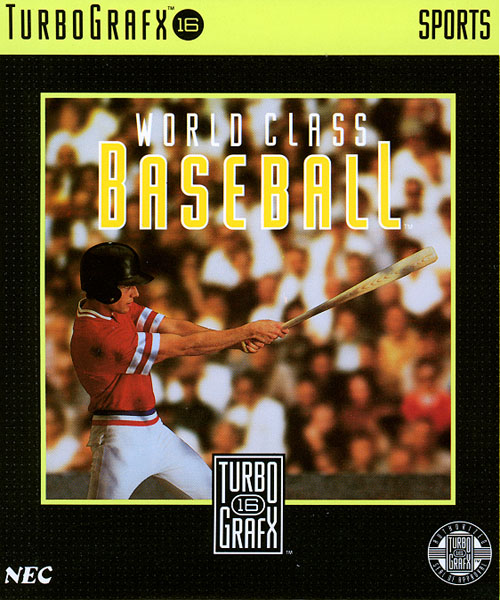
This blog is steadily marching on through history of baseball video games. We are now in the year 1989 and many new systems are now available. One of the new platforms is the short lived, TurboGrafx-16. I believe World Class Baseball for the TurboGrafx-16 is the only baseball game released in the United States. I should mention that even though 1989 is bringing us 16-bit gaming, the little system that could from the 70's, released it most advanced baseball game as well. I am referring to Pete Rose's Baseball for the Atari 2600 and 7800. Sadly I do not have a copy of the game so it is not included in this blog series at this time. Pete Rose Baseball was not really innovated in terms of baseball games go but compared to their 1978 Home Run game; it is amazing feat to still be able to produce quality games more than 10 years after its launch. It is too bad that in 1989, people traded in their Atari 2600 for a TurboGrafx-16 or Sega Genesis and Pete Rose Baseball did not do well in retail. Was the trade considered world class?
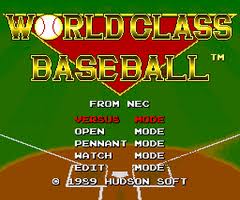
This is the first 16-bit baseball game in this blog series and from a graphics perspective; it is easy to see the importance of 16-bits compared to 8-bits. We can begin to see more textures and an increase color palette. The text is more readable as well as the baselines are very crisp and not jaggy. Regarding the text, the font has a nice thin black outline to them which make it pop up and not cause color bleeding. The B/S/O counts use different colors but oddly the arrangements of the three counts in the game are non-standard. The game lists it as S/B/O.
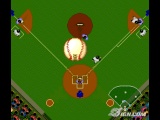
The field in the game resembles that of an astroturf field; the infield only has dirt around the bases for sliding but not along the base paths. The behind the batter view shows lawnmower lines in the field as if it was freshly mowed before the game. It is a nice graphical innovation and helps provides the gamer a sense of realism. The field contains the on deck circle, base path for first base, base coach boxes as well as base coaches. While I do like the fact they included the base coaches in the game, I found them more of a distraction than a nice graphical touch to the game. Maybe it was the camera angle or maybe because they look 100% like a base runner but I found myself throwing to a base because I thought I saw a base runner off the base only to realize it was the base coach just standing there. I think it would help the gamer if they added some separation between the coaches on the field vs the players on the field of play. I don’t find the umpires distracting because they are often wearing blue or black.
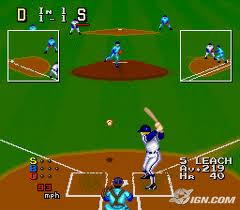
The behind the batter view has steadily gained improvements on the rendering of the players. The uniforms are now detailed, the batter has a helmet and the stirrups are very pronounced part of the uniform. The batting swing is also fluid and smooth. The catcher's straps are also well detailed. A new batter’s animation is introduced in this game. No longer do we see the batter sprite slide around in the batter’s box as we move him. The legs actually move like a human is expected to move. While the behind the batter view is detailed the overhead view sort of lacks detail. The overhead view is slightly boring and something an 8-bit platform can easily handle. During the fielding, the players all look the same and very generic. The game does not include the real MLB teams nor are players; the teams are made up so I can’t comment on how they compare to the real life players.
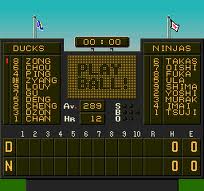
The scoreboard in this game looks very nice. The jumbotron is made up of small light bulbs that give it that pixilated look to video that you would actually see in baseball parks in the late 80’s. Scoreboards back then were just starting to get electric and video and you won’t actually see huge TV screen resolutions on scoreboards till the late 90’s. The scoreboard displays each team’s lineup and an indicator on who is up to bat as well as the current batter’s avg and homerun count. It does lack any information about the current pitcher however. The inning summary is displayed up to 10 innings as well as the game total runs, hits and errors. One thing I did notice is that inning run count was incapable of displaying double digits. I had 12 runs scored on me in the 8th inning one time and it only displayed ‘2’. FYI… there is no mercy run in this game.
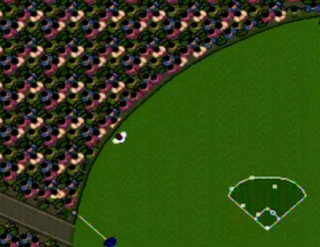
We continue to progress regarding the crowd in baseball video games. Here we see individual fans in the crowd as well as the seats they sit in. The crowd pattern for this game includes empty seats which is more realistic. All the fans have the same color hair, but different color shirts. They are all the same size as well.
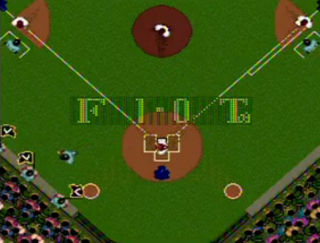
I would say only 2 bits of the 16 bits of the game was required to produce the home run celebration. The words ‘Home Run’ appear in the center of the screen as the ball lands in the stands. When the ball hits the stands however the ball didn’t disappear but rather continue to get smaller until it runs off screen, it was a weird effect that didn’t match the camera’s top down perspective. The camera stays with the crowd until the batter runs down the third base line and connects with the plate. The runner then goes back to his dugout where you see his teammates waving flags as he stands in front of them and waves his hands to the crowd. The celebration within the dugout is enjoyable to watch and hearing the home run melody is always fun to hear.
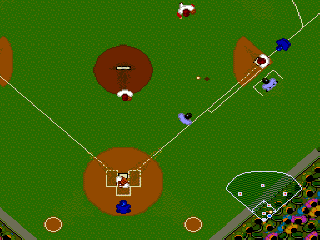
This game introduces a true top down perspective during the fielding. You only see the player’s helmet/hat and shoulders. The hands and feet pop in and out of the sides of the player while they run or throw. The catcher is rendered differently in the overhead due to the straps for his pads, nice touch. The camera switches to this top down camera during strikes out which lets us see the next batter approaching the batter’s box. Gone are the days in which the next batter just appears.
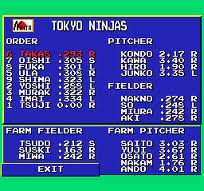
As we march through video game history, new concepts begin to emerge. The last entry we created a section for the scoreboard now we have enough history to compare and contrast the menu system within the baseball games. The menu system includes the process to pitch hit, modify lineup and or roster. The menu system in this game is very easy to navigate. As typical from previous games, the background for the roster management is solid blue with white text.
The melody and background music is really nice and catchy. When there is a runner in scoring position the music’s tempo picks up a little bit. The melody between innings was also pleasant. The umpires voices were not very impressive and sounded muffled.

Three standard modes and one new mode for baseball video games are included in this game
When fielders picks up the ball, he cannot freely move only able to move in a set path to a base or throw the ball to one of the bases. If you select a base to throw to and there is a fielder along the path of the ball, they catch the ball which forces you to throw the ball again to reach the base you intended in the first place. The best example of this is when you spot a runner stealing 2nd base, as a catcher you attempt to throw to 2nd base but the pitcher is in the middle of the throw and intercepts the ball. I ended up having to make the throw and then move the pitcher out of the way. This is not natural and really hinders the gameplay. It is not a deal breaker and something if played long enough will become something you just know you have to do. I feel throwing the ball is a tad slow; I feel the runners can run faster than the throw which makes double plays a rare thing. The fielding overall is really bizarre. It seems like we are back in the late 70's where you are controlling fielders as a unit, Which sort of worked in the old days when the whole playing field was displayed at once but when a ball zips through the infield and in the outfield it is frustrating, at point you are moving the infield up but then switch to the outfield and move the players down. I had to mentally think that the fielder I am really should be controlling is the outfielder that isn't in view yet. I found myself focusing on the small picture in picture of the field more than the main camera to get an idea on where I need to move
I didn’t have many problems with the offensive side of the ball. The batting was nice and fluid. I felt I was able to move the batter where I wanted and make contact with the ball. I did however notice that controlling base runners is my weakest part of my game. When the bases are loaded chances are I will screw it up and get a runner caught in a run down. This is not a knock on the game but more on my inability to control 4 baseball players at the same time. The base running mechanic is the same as the 8-bit version of the sport. This is due to the system having the same number of buttons and options.
This is truly a gem of a video game regarding the aspects of baseball. The ability to edit a roster as well as the lineup really puts you in control of your team. The teams and players are not licensed by MLB or any established league so there is no joy of playing as your favorite player. The players didn’t have numbers on the backs of the uniforms which I missed.
This is a series of blogs based on my own personal game collection. I will attempt to go through them in a chronological order according to their release date. I will also attempt to play then on their original platform using the original controllers the game was designed for. If I am unable to get the system or the game working then I will use PC emulation or another platform emulation like the Intellivision Lives! game for the gamecube
Previous entries
| 8. Intellivision's World Championship Baseball (1983) 9. Sega Master System's Great Baseball (1987) 10. Nintendo's Bases Loaded (1987) 11. Nintendo's R.B.I Baseball (1988) 12. Nintendo's Major League Baseball (1988) |
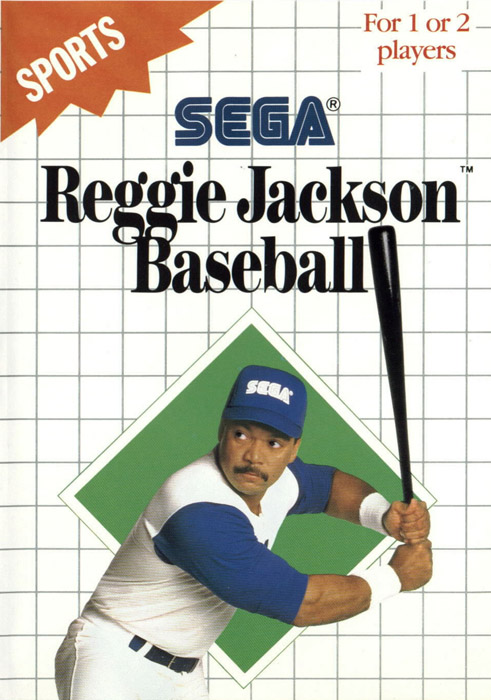
While the Nintendo gamers had three baseball games to play, the Sega Master fanboys only had 1 until Reggie Jackson's Baseball was released. You can make the argument that Reggie Jackson is a sequel to Great Baseball released in 1987 or a proof of concept for their Genesis game to be released in 1989. Gone is the behind the pitcher view; In is the behind the catcher view. Reggie Jackson was an extremely popular baseball player in the 70's and early 80's. Maybe not intently but Reggie Jackson retired from the sport in 1987, a year before this game was released. This fact makes this game the first video game console game to be named after a MLB player as well as a retired MLB player. Reggie was a power hitter for many teams; does this game have the power to earn itself a home run?
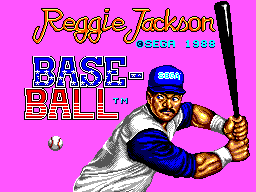
This game is a step up from Great Baseball released just a year prior for the Sega system. While Great Baseball had animations on the jumbotron, this game improves on the concept. I don't want to be viewed as a caveman but when I play a baseball game, I could use a little less pink in my game. The color of salmon is spotted all over this game; the pennants, the icons for the Ball/Strikes/Out, the title screen as well as the team uniforms. I will assume Reggie Jackson demanded the color thus not darn to question his judgment. This game is a good example that the Sega Master System might have better graphics capabilities of the NES but just lost the race for market share.
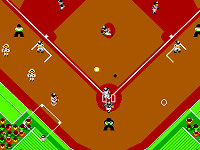
I can't ignore a weird innovation this game provides the player and that is when you start a game of baseball, the color of the field is randomly selected. The color of the grass you end up playing on is red, green or yellow. If you were wondering why this concept never became a staple feature in future baseball games, press the reset button until you get the red field and have fun. If you can look beyond the color of the field, this game includes nice additions to baseball video games that exists in real life such as base coaches, batter in the on deck circle, relief pitcher warming up near the dugout, relief pitcher golf cart, warning track along the outfield wall and of course cheerleaders... Yes this game has cheerleaders, this game is that innovated. Also I have to point out that during the pitch the field and dirt around the batter's box contains some textures and has a 'used' look which I found refreshing.
| Red Grass | Green Grass | Yellow Grass |
|---|---|---|
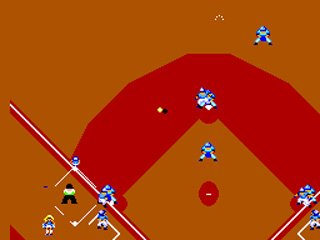 | 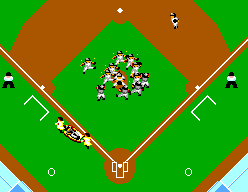 | 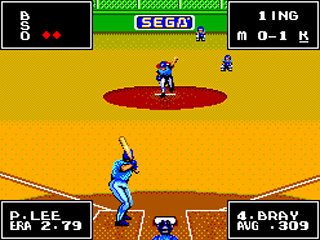 |
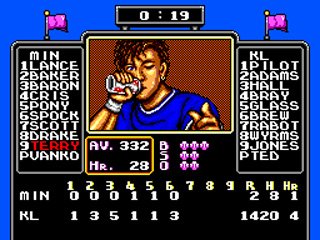
I have decided to add a new subcategory which details the scoreboard. We are now at a point along the baseball video game history timeline where the scoreboard is the center of information regarding the game. As with the Great Baseball prior, this game included cartoony animations on the scoreboard for entertainment value as if you were watching a real baseball game. The scoreboard includes the lineup of teams, the Balls/Strikes/Outs, BSO, as well as the run summary of every inning including a game summary of total runs, hits and home runs as well as a running game time. It shows the current batter's average and home run count.
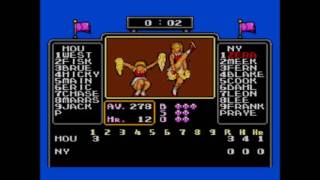 | 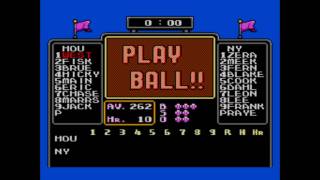 |

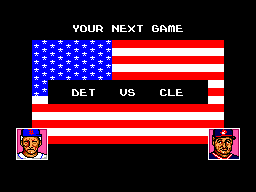
As many innovations this game provided regarding the field, It doesn't provide the same level of innovation regarding the players. The batter is nicely rendered and we can see the pinstripes down the pants as well as the pitcher animation of waving off the catchers signs. Once the ball is hit the players are less detailed. The color schema of the uniforms between the defense and offensive makes it hard to tell which is which during infield plays. One of the player innovations is the each team includes a profile picture of the manager. The image of the managers resembles the actual team managers during the 1987 MLB season.
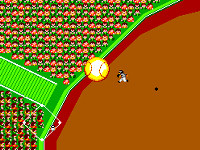
Always appears to be the weakest section of the blog, I am happy to report that we can see a slight improvement regarding the crowd with Reggie Jackson's take on baseball video games; Thank you Reggie, Thank you. The crowd includes various shaped individuals. Well only their neck and face but at least it is a step in the right direction. They even have hands that appear to clap and they move their face side to side. The crowd is just a duplicated pattern to fill all the seats

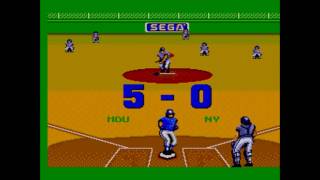
Good thing the game's home run celebration is fun because It happens a lot. Once the ball disappears, a popup widows shows up and nice big words "Home Run" in a typical wireframe 80's 3D effect. Like Bases Loaded before it, every home run includes a nice cartoon animation. Unlike Bases Loaded it occurs when the runner touches home plate instead of when rounding second base. I am not familiar with Reggie Jackson's playing days but the runner looks more like David Ortiz then Reggie Jackson. As he approaches home plate, he stops and then proceeds to jump and stomp on home plate as he flexes his muscles. Nice touch when you are the one who hit the home run, annoying if you are the pitcher.
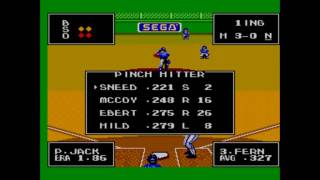
Instead of using the scoreboard to manage the pitch hitting and change of pitchers, a separate popup window appears listing the various players that can be selected. The batting is done by the behind the batter viewpoint and it appears as well the behind the pitcher view of Bases Loaded is quickly becoming an oddity and not the standard or expected viewpoint that gamers want. One aspect regarding the camera that spices the genre up is when the ball is in the air, the ball grows in size as if the ball was approaching the actual camera above the field. The side effect to that is the shadow of the ball is positioned to the side as if simulating a real light source. My problem for the shadow is I have grown up with the 'Nintendo Shadow Rule' where an object's shadow in a video game does not exist to show lighting effects but to help the player understand where the object is located within the space of the game. The shadow in this game is distracting and is hard to gauge where it might land.
Not much to the sound of the game. The background music is only 3-5 notes and repeats itself. The umpire has a nice voice to it and even says words like "Strike Out” We can hear the umpire in video games are increasing being more vocal and an increase their vocab.
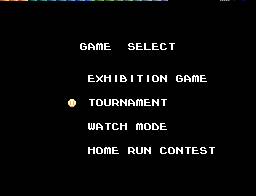
Standard Modes
FYI I am looking forward to seeing which game is the first to have a career mode. Bases Loaded is the closest with having an 80 game season. If I had my choice I would ask the developers to get rid of Watch mode and put that freed up space towards career mode.
The addition of the warning track near the outfield wall is not just a graphical improvement but also a gameplay element. The ball when it rolls or hits the warning track slows down and behaves differently than the outfield grass. Speaking of fielding, this game lets you manually control the outfield or have the CPU control the positioning. You still have control of the fielder once he collects the ball and you can run with the ball or throw it a base by pressing a direction on the dpad and pressing B. I noticed the field is really big, there where hits that landed in the grass and nothing was in the screen with me besides the ball. The pitching ability is par for the course for the late 80's video game. You have control of the ball as it floats towards home plate. A defensive baseball concept makes it's appearance in this game and that is the ability to have a fielder jump to try to grab the ball in the air.
I mentioned previously but It appears as though Home Runs are very easy to make, thus making this an offensive focus game. I am not surprised given Reggie Jackson wasn't known for his defense plays. The batter in the game cannot move up and down in the box only left and right, which is opposite of the last game in the series. Like NES's Major League Baseball before, I didn't find this gameplay limitation effect my ability to hit the ball where I want it. I felt I was able to pull the ball etc... Base running was just as easy to execute as hitting the ball. After a few tries I was able to steal bases with ease.
I was unable to edit my lineup and roster so I feel we have gone backwards regards to becoming a team manager. The game is a solid baseball game. It does a nice job of highlighting big plays by zooming in at home for example. This provides that sense of thrill during baseball games that is mostly missing from the video game versions of the sport. Another thrill of a baseball game is what happens when a batter is hit by the pitch; not only does the batter kneel down in pain but the camera it switched to the bird's eye view and both dugouts empty as the game medics carry the batter off the field. It's pretty nuts, oh Reggie.
This is a series of blogs based on my own personal game collection. I will attempt to go through them in a chronological order according to their release date. I will also attempt to play then on their original platform using the original controllers the game was designed for. If I am unable to get the system or the game working then I will use PC emulation or another platform emulation like the Intellivision Lives! game for the gamecube
Previous entries
| 8. Intellivision's World Championship Baseball (1983) 9. Sega Master System's Great Baseball (1987) 10. Nintendo's Bases Loaded (1987) 11. Nintendo's R.B.I Baseball (1988) |
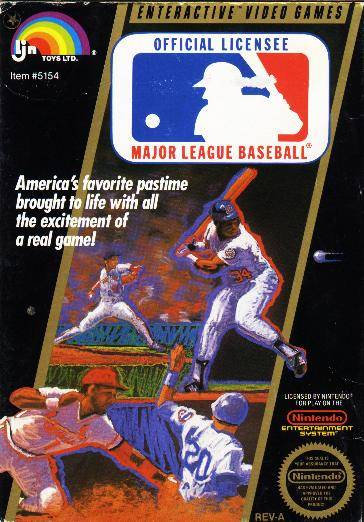
Video game players who had a Nintendo Entertainment System were lucky enough to have three baseball games released back to back to back in 1987-1988. The first was Bases Loaded, which didn't contain any MLB teams nor MLB players’ names or stats. The second was the ever popular R.B.I Baseball game that included MLB player names and stats but no MLB teams. Last but not least is Major League Baseball, as the name implies, officially licensed by the MLB. This is the first game to include actual MLB teams and players stats. MLB player's name is trademarked by MLBPA and as a result the player's names are not included and every player is referenced by only their number. Does the lack of the players name hurt the gameplay? Next up to the plate is #12.
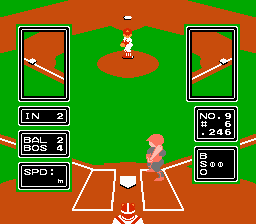
If you quickly glance at the screenshot you might think it was RBI Baseball. The two games look really similar; the impact of RBI Baseball is starting to shape up. The pitcher/batter duel contains a lot of popup overlays like a windows application. The inning count is in a separate box, the score in another. One info box that always appears is the speed of the pitch but the speed disappears as soon as you select your next pitch. In general the text is always readable; it always is on all NES games that use the default font. One of the aspects of the graphics that simply gets the job done is the menu system. In this game you have complete control of the lineup and the menu system for this feature is ugly and only contains text on a solid blue background.
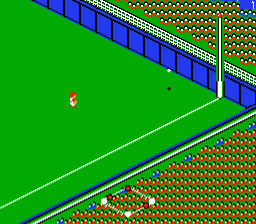
We are still in the era of video games where things look cartoony. I say that as a positive thing; The platforms in the 80's just can't display textures and as such the graphics such as a baseball playing field use solid colors. The dirt is a solid brown and the grass is a solid green. The field has a nice sense of depth, the outfield wall has height and the ball bounces of it fairly correctly, the foul lines are tall and extend past the outfield wall. The scoreboard compared to the other games released the same year is really dull and don't include much of anything besides the score.
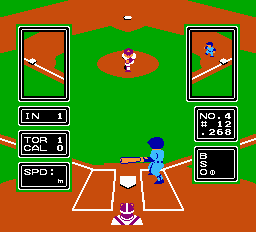
The rendering of the players are very much like RBI Baseball game. The batters have helmets and the batting stances vary like Bases Loaded. The uniforms have accurate colors schemes according to the MLB teams' official colors. The first and third base cameras are not as zoomed in as the batter and so the detail of the base runners are reduced. The back of the catcher is also displayed and the lines of the catcher’s mask are correctly displayed as well as the straps of his pads.
Another baseball game, another game where the fans are displayed as ugly wallpaper. If you have been following these blogs you might remember how happy I was to see crowds in the game, Now that I have seen crowds I am getting tired of lack of innovation. Below screenshots may help prove my complaint; Can anyone honestly say the crowds in Major League Baseball are years better then Nintendo's first Baseball game?
| NES Baseball (1983) | Sega Great Baseball (1987) | NES RBI Baseball (1988) | NES Major League Baseball (1988) |
|---|---|---|---|
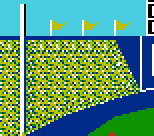 |  | 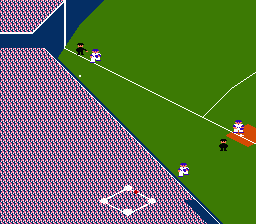 |  |
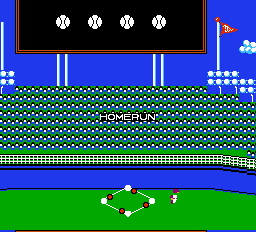
This has to be the most boring celebration on the NES so far. The camera doesn't move from where the ball landed in the stands. The crowd roars and the word 'Home Run' appears in the center of the screen as the score is also popped up as each base runner touches home plate. If you manage to hit the home run near the scoreboard you can notice the scoreboard displays just 4 large baseballs evenly spaced.
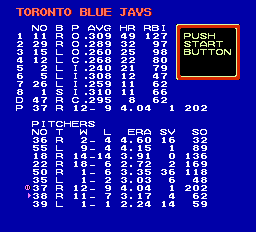
The camera displays the field at a very nice angle that provides the user with a great sense of depth. As typical with baseball games of this era fielding is difficult because the camera focuses on the ball and not the fielder so a lot of times you have to guess where the fielder is related to the ball because the fielder is out of view. One of the biggest issues I have with the game is the fact that for some reason, this game has a load screen when it has to change cameras and screens. The load screen gets in the way of the game play and delays what is already a slow sport. It is really noticeable when you hit the ball and have to wait to see the direction of where you hit it.
I also can't leave without mentioning the ugly menu system when controlling the lineup and manager choices. The entire screen from top to bottom, left to right is white text on a blue background. Being a windows user, I usually refer to this as the blue screen of death. I greatly appreciated the ability to manage my own line up. It truly is a great innovation in terms of baseball video games but I am really looking forward to a developer taking this to the next level and making the menu system easier to use and easier on the eye and less like I am reviewing a spreadsheet for a school project.
There is no background music besides the radio static noise that I guess is supposed to be the sound of the crowd. The game does include some classic ballpark jingles and chants such as the 'Charge'. Besides that, nothing really special.
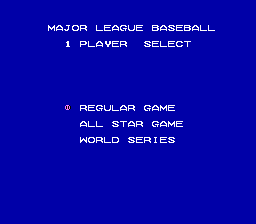
We have three modes for 1 player and a single 2 player mode
I do have to say the game physics take a while to accept and learn. One aspect of the physics that seem different from the 11 other baseball games I have played this month is that the ball doesn't roll as one would expect it to. After 1 or 2 bounces in the grass it simply stops as if the outfield turned into green glue paper. I wouldn't bash the developers for having inaccurate physics; it is just different and takes a little learning curve to fielding and running around to collect the ball. Another aspect of the defense that seems odd is I couldn't figure out how to tag a base to get the force out. It seemed the game didn't let me pick up the ball and run to the base ahead of the runner; either I had to tag the actual runner or throw it the base. This affected me more the green glue outfield because I had to change the way I normally play the game during various situations. For example If there was a runner on third and my opponent hits a line drive to first base, I would have the first baseman pick up the ball and move to the base for the force out. But here if the first baseman collects the ball there is nobody to on the base to throw to so I have to run down and tag the runner myself which is just enough time for the runner on third to score. Maybe I totally missed something in the instructions but I tried everything. The pitcher can't move on the mound and the throw animations are at times not smooth, sometimes the ball changes speeds in mid-air
The batting isn't bad, the inability to move the batter left and right and only up and down is a little different than previous games but I didn't feel I missed that freedom. To perform a bunt just a tap of the A button, to swing for the fence hold down the A button. This tapping vs holding down the button is start of maybe some analog control of the swing and a step in the right direction. Performing a pitchhitter change is nice and easy, the game provides enough stats to make you feel like you can a sound decision like a baseball manager would.
Ability to manage your lineup is all I need to hear to know that this game adheres to standard rules of baseball. This is the first baseball game that gives the power of forming a lineup in the player's hand. When you select your lineup, you cycle through general positions such as infield,outfield,catcher and pitcher. The game forces you to have the correct number of infields and outfielders but doesn't list the actual position such as first baseman, shortstop, left field...etc
The physics in the game does hurt when dealing with how baseball is played; Baseballs are round and suppose to roll in the outfield. Because this game is licensed by MLB, it does a touch of respect in terms of how baseball is played.
The stats included for each batter are AVG,HR,RBI,as well as left/right handed.
This is a series of blogs based on my own personal game collection. I will attempt to go through them in a chronological order according to their release date. I will also attempt to play then on their original platform using the original controllers the game was designed for. If I am unable to get the system or the game working then I will use PC emulation or another platform emulation like the Intellivision Lives! game for the gamecube
Previous entries
| 7. Nintendo's Baseball (1983) 8. Intellivision's World Championship Baseball (1983) 9. Sega Master System's Great Baseball (1987) 10. Nintendo's Bases Loaded (1987) |

The late 80's brought about a new era of baseball video games. The first entry of popular baseball game franchises will make there start during this time. Nintendo was taking over the family TV and baseball was quickly becoming the most popular sport video game. Last entry of this series introduced the Bases Loaded; here we introduce the popular R.B.I baseball series. From here on out Bases Loaded and R.B.I will continue to produce sequels and compete for the market share. R.B.I. Baseball included many new innovations but they all dwarf in comparison to their greatest innovation which was including actual MLB player names and their stats in the game. No game before could I play as my favorite real life ball player and after R.B.I Baseball not sure if I can go back to generic players. Keep in mind however that they only had a contract with the players association and not MLB so the teams were still generic and team names only consisted of the city
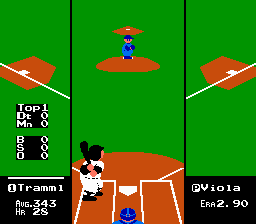
One general rule to keep in mind while playing R.B.I. baseball is the presentation style is cartoony and less realism. Bases Loaded attempted to present the players, field as real as possible, R.B.I Baseball simply doesn't. All the players are short and fat and the uniforms are very colorful and bright, The speed of the game is a lot faster than how baseball is typically played. Overall there is a general 'arcade' style to the graphics. The game splits the pitcher/batter duel into 3 vertical cameras. On the left we see a close up of third base, the middle is the batter and pitcher as well as 2nd base in the distance and on the right is 1st base. With game time information easily readable to for the user. The current batter's stats are always displayed as well as the pitcher's information. If you are a fan of baseball stats than you will fall in love with this game; All the game stats are very easy to read and use the correct baseball abbreviations.
Even though this is the first game to include real life MLB players, each batter, base runner and pitcher contains unique stats that affect the gameplay, graphic wise they sort of dropped the ball. All the batters look the same. They are all white with a little belly fat to them. Their bats are a little cartoony, and wide, the width of their helmets. The base running animation is pretty smooth and I enjoy the way the base runners are shown when they get ready to steal. It appears as though every play ends up being a slide into the game, which is a little odd but still somewhat enjoyable to watch as you feel the play was close. The batter can move about inside the batter's box as well as the pitcher can move about on the mound.
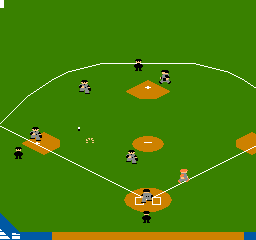
The pitcher/batter duel display shows a really detailed close up of all the bases and is easy on the eye. The infield however is less detailed. I can only assume the stadium is in a dome because there is no infield dirt along the base paths only around the bases itself. A lot of Astroturf fields during the 80's had their fields constructed this way but for a very game it seems a little weak. Once again we presented inside a stadium, which I think it is safe to say par for the course now in baseball video game history. There is no way a game can come out that doesn't include stadium graphics such as outfield walls, flags, and scoreboard and take itself seriously. There are umpires positioned on the field which is increasing become standard for baseball games as well and always nice to see. One of the field innovations this game includes is the stadium lights. The games are all played at night and as such along the stadium walls you can see the lights. There is no lighting effects but rather just white circles grouped together to represent light bulbs

For the love of all things that are video games, when can we actually see individuals in the crowd or at least see a crowd that looks like it contains actual humans and not some wallpaper pattern that can be seen in my grandparents living room. The crowd in this game is under par. I am not sure why games continue to use this method of displaying a crowd, maybe the system just can't handle animations of that size?
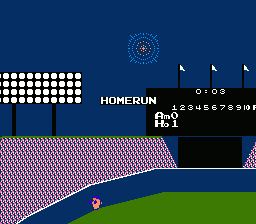
Bases Loaded still has the best celebrations in my book but this game isn't bad. It takes a page from Super Mario Bros and displays nice fireworks celebration. Because the games are played at night why fireworks shouldn’t been shown right? Real baseball should adopt this feature. Like Super Mario Bros, the numbers of fireworks are not random; 5 fireworks for solo home runs, 6 for two runs, 7 for three runs and 8 bursts of colorful explosions for a grand slam. The number of fireworks makes this game of the firsts to do something different for grand slams vs home runs.

As much as the popular behind the pitcher view has become in the late 80's, this game improved the tried and true behind the batter view. What makes this game unique and the game's most visual unique feature is the screen is split into three separate screens. The base runners are not displayed in a picture-in-picture view or a graphical icons representation. This game has dedicated cameras for each base and during the pitch you are presented with all three camera views. It is not as confusing or busy as it may seem and nice attempt to present the gamer with the entire information one needs to manage and play a game of baseball. When the ball is in play it goes to a one camera system with a graphical representation of the base paths to determine the location of the base runners at all times.
This is the second baseball game that has background music, the first being Bases Loaded. While the bases loaded background wasn't memorable, the background music for this game is almost unbearable. It included looping over the same 5-8 note melody and was very 'beeb-boop' The sound effects for this game wasn't that great either and there was no umpire voice calling the plays. This is the biggest area of improvement the developers should make for RBI Baseball 2.
RBI Baseball provides the user with three different modes of play
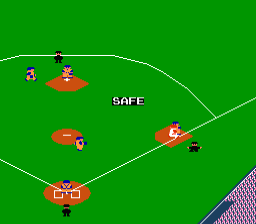
We are at our 11th entry into this series and as such the gameplay on the defense and offense really hasn't changed. To field the ball you control the person closest to the ball. I found catching a pop fly a little challenging than what it should be. It was hard for me to determine where the ball is going to drop and I noticed myself focusing on just the shadow of the ball. The ball itself does increase in size the higher it is but when the ball is so high it is out of view you have no idea if it is coming down or still going up. It might be improved if the size of the ball's shadow increased as well. Also I feel the pitching is short and fast, I can easily pitch over 100 mph fastballs.
Nothing too out of control on the offensive side of the ball. I am able to move the batter around the batter's box as well as control the speed of the bat and perform timely bunts. You can take control of any base runners as well. Maybe it is me being confused with all the baseball games I have been playing but I found it hard to bring a base runner back to their starting base. I had alto of outfield popflys turned into double plays against me because the CPU auto moves the runners halfway. One side thing I did notice is when you strike out, your batter gets pretty upset and cries. Is this little league?
I mentioned a couple entries ago that the direction these games are going, there appears to be different sub genres. Arcade baseball games and simulation. RBI Baseball would fall in the arcade style in terms of gameplay but includes enough stats and strategy that it can viewed as a baseball sim. There is a mercy rule for the game to make the games move along faster. All the players have increased number of stats associated with them and the stats help setup matchups. There are players that are fast, players that hit the long ball more than others; as such you have to manage your game a little more closely like a baseball sim. The stats are real and taken from MLB 1986, 1987 seasons and the teams you can select are the division winners during those seasons as well.
There is no major misstep in the general rules of baseball and because of this; RBI baseball is a real solid baseball game.
This is a series of blogs based on my own personal game collection. I will attempt to go through them in a chronological order according to their release date. I will also attempt to play then on their original platform using the original controllers the game was designed for. If I am unable to get the system or the game working then I will use PC emulation or another platform emulation like the Intellivision Lives! game for the gamecube
Previous entries
| 5. Microvision's Baseball (1980) 6. Atari 2600's RealSports Baseball (1982) 7. Nintendo's Baseball (1983) 8. Intellivision's World Championship Baseball (1983) 9. Sega Master System's Great Baseball (1987) |
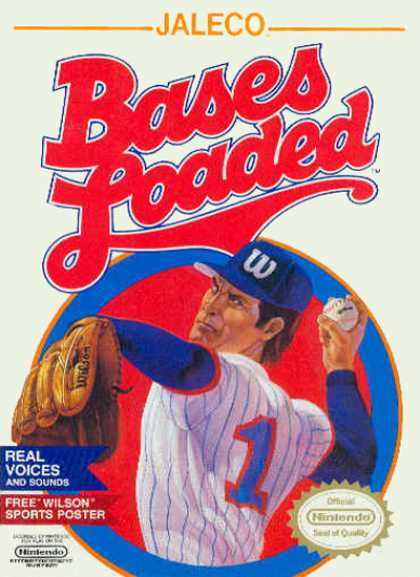
If I had to do this list based on which baseball games I enjoyed playing in my youth, Bases Loaded for the NES would be the game. I fell in love with this game as a kid and I remember endless hours in front of the TV playing this game. I used to keep a notepad next to my NES just for games like this. This game you can play a whole 80 game season and after each game you are presented with a password to save your progress. This is before internet so my notepad filled with passwords became the most important sheets of paper ever to exist. I have been looking forward to going back and playing this game ever since I decided to start this blog. I wasn't the only one playing this game at the time, a couple years later a sequel was released and at which time became a game franchise across multiple platforms. This is one of the first baseball games to accomplish this feat. Baseball games up this point were one and done. Let's see how the Bases Loaded franchise started.
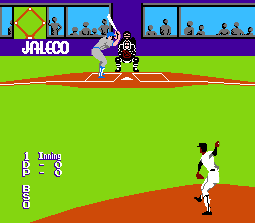
Sega's Great Baseball and Nintendo's Bases Loaded were released within months of each other in Japan. Because of these close release dates it is hard to determine which game established the infamous behind the pitcher camera view during the pitcher/batter duel. To this day when you read reviews of the game people either enjoy this view or don't, for the record I enjoy it. I find that I can see balls and strikes easier than what we have had in past games which were from the top down perspective. Not only was this view enjoyable to play in but they included simple touches to addma nice realism to the experience as if you are watching the game on TV. Like Great Baseball, they included a picture-in-picture bird's eye view of the infield so you can see where the bases runners are currently positioned. Unlike Great Baseball, it was better positioned and didn't float in the air and get in the way of the action. It was positioned along the backstop and part of the wall. The text is also readable and I always knew the current count and score. The batters count uses baseballs as icons which always make things easy to understand.
I mentioned the simple truth that I love 80's baseball uniforms in the last blog entry and this game doesn't disappoint. The stirrups are nicely rendered and as well as the high socks. Because of the behind the pitcher view we now can see their uniform number printed on the back of the uniform. Can video game graphics get any more real than this? The outfield top down view is zoomed out and thus the players don't have much detail however. I wish someday developers can be more creative with these outfield views. The players have different skin color which makes it more real as well. One of the greatest and yet simplest graphical advancement this game introduces us to is different batting stances for the players. Not only does each batter have different stats associated them but now are graphically different. Each batter does not have a unique stance but instead 1 of 3 different stances.
| Three different batting stances | ||
|---|---|---|
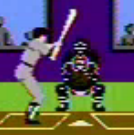 | 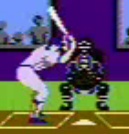 | 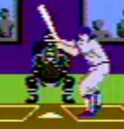 |
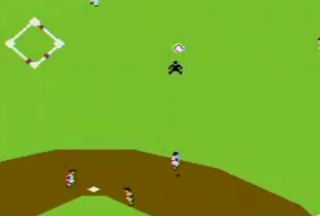
Right from the start I should mention that while the NES was not the most powerful machine out there in 1987, what it have was a dedicated set of code for screen scrolling. Scrolling on the NES is very smooth compared to other systems. With this added ability, Bases Loaded naturally becomes one of the first baseball games to invoke scrolling during the play. We are now at a time where the camera doesn't have to be zoomed out to show the entire field and all fielders on the screen at the same time. When the ball is hit the camera follows the ball and the field scrolls behind it. Playing the game this way has its advantages and disadvantages. One of the disadvantages is when the ball is hit towards the outfield your fielder is not always visible on the screen and you don't really know what direction you should move to collect or catch the ball. The advantage to this approach is when you throw the ball from the outfield to the infield or when the ball hits out to the outfield the screen smoothly follows the ball and doesn't require change of the camera view which might get disorientated users for a critical split second. As far as concepts of the field that is new to video games, we now have the on deck circle and the base coach areas along 1st and 3rd base.
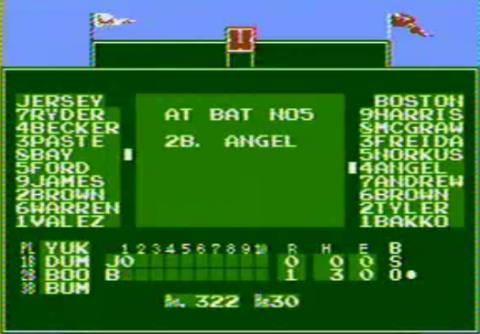
The scoreboard is something we are starting to see improved with each game. We have gone from not having any at all to animations in the jumbotron like we see in real ball parks in the 80's. The scoreboard provides more information. It now displays the lineup of teams as well as the current batter's average as well as number of home runs. The scoreboard includes a unique feature I haven't seen before and the initials of all the umpires. The flags on top of the scoreboard did not wave in the air and are static. The cut scenes on the scoreboard occurred during homeruns, pitch hitting and bringing in a relief pitcher. Calling another pitcher was my favorite since this was during the time when a golf cart actually went on the field and dropped off the pitcher... I love the 80's.
The crowds in this game are slightly disappointing. They are shown during the game but very boring and dull. The one thing that does exist though is there are fans displayed during the pitcher/battle duel. They are individual people but a solid grey and they are not animated.

Hands down the best home run celebration to date exists in this game. As soon as the ball hits the stands, the camera moves to the scoreboard with the big letters "Home Run" then the scoreboard is zoomed in and takes up the entire screen where a video of the pitcher is shown kneeling down in disgust as the base runner is shown running behind him pumping his fists in the air. If there are other base runners during a home run they don't leave for the dugout after touching home plate but rather stay on the field and provides high fives.
I already mentioned it but shouldn't be forgotten this game's camera work is one of the kind. Never before has the camera actually followed the ball like it does in this game. In previous games the camera was static; everything had to be seen in one camera angle, which is why bird's eye view was the most popular way to show all the action. This game helped introduced the behind the pitcher camera during pitches. The scoreboard camera provided the user all the game info including rosters, current batters and menus for managers such as selecting a new pitcher. While the moving camera was not perfect, it is a start and great innovation for the industry.
The sound chip in the NES is pretty impressive and we have heard some great melodies from previous games such as Super Mario but none of the sports games are that memorable including this game. The melodies in the game are nice and quick. They occur during the home run, every half inning and whenever there is a pause of the game. One of the small addition to the sound of the game that I enjoyed was when you pause the game you can hear the umpire call time. The umpire's voice is clear and doesn't sound like a robot as previous games sounded.
There are only two modes in this game; Pennant and vs. Mode. The first option is only for single players in which you try to play an 80 game season with your team. After each game you are given a password so you can continue the season at a later date. In the 80's I managed to complete the entire season which was a video game memory I will never forget. This concept of playing an entire season was amazing for its time and something that I always look for to this day when I play any baseball game.
Standard controls for the defense side of the ball. With the scrolling of the field it does make it hard to know where your fielder is sometimes but in general if you don't touch the controller the CPU moves your fielder towards the ball anyways. I find that this helps a great deal once the ball is in the air. Instead of just throwing to a base with the other button you can now run to a base. This helps with when you catch someone stealing. The pitching is standard as well, with the d-pad you select the type of pitch. You can change pitchers at any time. I found the ball to move more natural than previous games. It doesn't appear to float into the fielder’s glove as well as it travels faster than the base runners as it should
I might be incorrect but I believe this was is the first game in this blog series where I feel I have control over the direction of the bat as I swing. I cannot move the batter in the batter box but I feel using the d-pad I can hit an high and tight pitch as well as a low golf type swing. When you have base runners you do have control over which runner you want advance. At any time you can select to pitch hit. The batter's avg and home run count appear to matter in the game, as there are power hitters and non-power hitters.
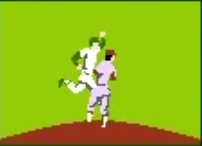
The greatest thing about this game is the fact when the pitcher hits the batter not only do you get to go to first base but there is a chance the batter will charge the mound and a good old fashion brawl will occur which you can follow on the jumbotron. After the fight is over you are forced to select a pinch-runner for the batter has been ejected from the game. If this isn't the best aspect of baseball to be incorporated in a video game I don't know what is. I also like the umpire movements behind the plate and on the field.
We can pitch-hit, pitch-run, change pitchers but that is all we can do regarding game management. We do have a line up but currently have yet been able to manage the line up before the games. We can however select a pitcher which the only pitching stat we can go by is ERA.
This is a series of blogs based on my own personal game collection. I will attempt to go through them in a chronological order according to their release date. I will also attempt to play then on their original platform using the original controllers the game was designed for. If I am unable to get the system or the game working then I will use PC emulation or another platform emulation like the Intellivision Lives! game for the gamecube
Previous entries
| 5. Microvision's Baseball (1980) 6. Atari 2600's RealSports Baseball (1982) 7. Nintendo's Baseball (1983) |
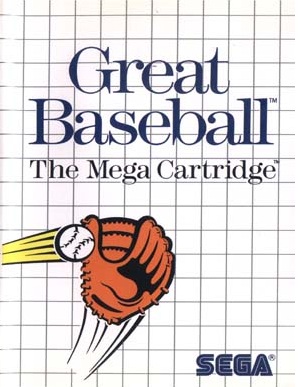
In 1983, Intellivision released one last baseball game, World Series Baseball, before the video game crash and the end of the Intellivision system. The game was a graphic milestone with picture in picture and camera views much like how the sport is shown on TV as well as play by play voice work. You can only buy the game via mail order and hard to find these days. Colecovision also released a baseball game towards the end of the system's life, Super Action Baseball, in 1983 as well. Like Intellivision's World Series Baseball the graphics was ahead of the time but the game was doomed because it required Coleco's Super Action controllers which were not very popular and not included with the system. After the video game crash, the country wanted to play baseball video games again, in 1987 Sega pleased the masses and released Great Baseball. There is a theory out there that any game that includes the words 'Great' in the title is anything but. Does this game break the curse? Let's play ball!.
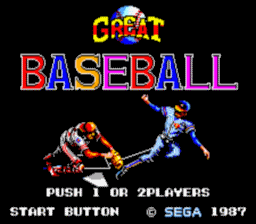
From the start you can tell that this game is going to be enjoyable to look at based on the title screen alone. The title screen contains a nice rendering of a base runner about to get tagged out at home. We begin to truly see 8-bit graphics and what they could look like . When you start the game a detailed view of pitcher, batter, and umpire are displayed. The game info is located at the bottom of the screen in an organized fashion and readable. The text is simple white on a solid black background. To help the user see the base runners, a bird's eye view of the field is also displayed in a picture in picture format.
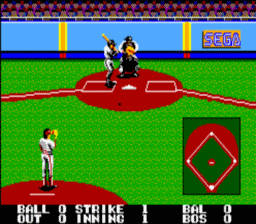
I have a confession to make; I love 80's sports fashion. I love baseball's stirrups, colors and stripes of the 80's. This game renders this 80's style of the uniform pretty good. This advancement in player graphics is due to the change of focus and ability to show different views of the game. Now we can zoom in on the pitcher and the batter during pitches. The pitcher/batter combo easily takes up majority of the screen. When the ball is hit the camera zooms out and we get the typical overview of the entire field and the player size is reduced as well as the details of their uniforms. The animations have really advanced as well. The swing of the bat and pitch are really smooth. We get to see the pitcher kick his leg out like how you pitch a baseball in real life.
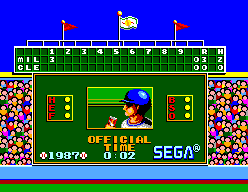
The field and stadium in general remind me a lot like Nintendo's first Baseball game for the NES. It is slightly more detailed and wider. The scoreboard is in the center, the shape of the outfield wall is the same. Both have batter boxes, scoreboard, and foul poles. The scoreboard during the play includes initials of each team, summary of each inning as well as total runs and hits. The Nintendo game did not include hits. This wasn't the only advancement of the scoreboard in Great Base however, between innings the scoreboard is takes up the entire screen and is more detailed and pretty impressive. For the first time we get to see a small video clip of baseball players as it would be displayed on a jumbotron. The animation was not of an FMV quality, more of a cartoon look to it. This expanded view we see a running game time, current count and flags waving in the air. The animations cycle through 3-4 different ones at random.
| Sega's 'Great Baseball' (1987) | Nintendo's 'Baseball' (193) |
|---|---|
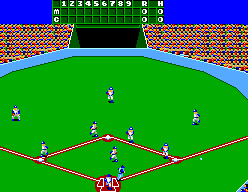 | 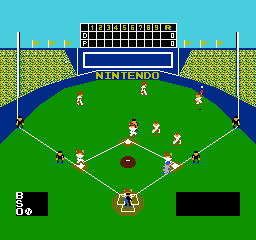 |
The crowd is displayed and also more detailed then NES's Baseball. I can tell that the crowd is still nothing more then a repeated pattern but when they get excited during a big play they have more animations besides a rapid change of color. During the scoreboard view, the crowd is even further detail and we begin to see individual people in the stands.
When I first witnessed the jumbotron in this game, I couldn't wait to see how they incorporate it during home runs. I was left pretty disappointed; the jumbotron isn't even used, there is no cool animation shown and feel like it was a huge mistake not to include it. Sure the crowd goes nuts and moves around and the words 'Home Run' appears below in the scoreboard in outfield view but that is about it. It does have a nice melody to help with the celebration.
There are four different cameras and different views during the actual gameplay and two additional screens for the information. During the pitch, the camera is positioned behind the pitcher when you pitch as well as hit. Once the ball is hit a bird's eye view of the outfield is displayed that contains the entire field, outfield wall, pitcher’s mound. If a fielder throws to a base, the screen is switched to an infield top-down perspective.
| Behind the Pitcher view | Bird's eye view | Top down view |
|---|---|---|
 |  | 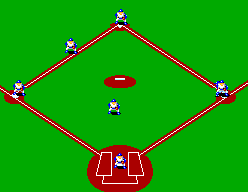 |
The lack of jumbotron during the home run celebration disappointed me first; a close second was the sound or the lack of sound. I am disappointed mostly because we are now in 1987 and we still have to play baseball in silence. Yes there are melodies before each half inning and during home runs as well as the title screen but that is it. Besides the sound effects and the umpire calling the plays there is nothing else. The sound effect of a strike or a base hit is also really bad, it sounds like my cartridge is busted but it's not. The umpire does speak and has a clear voice but that is the only positive thing I can take away from this game
There are a grand total of 6 different game modes in this game. With technology advancing, developers are started to add different modes that use the same graphics.
Pun intended when I say the defense in this game isn't great. I had such a hard time controlling the fielders that I switched to level 1. The fielders were running in slow motion and infield home runs were common when I was playing in Level 2 mode. Pitching in this view was a nice change of pace, It was different and because you see the ball hit the glove I had a greater sense of control. As pare for the course these days, the direction of the d-pad controls the pitch type; Up for a fast ball; Left for a left curve; Down for a Change-up. One of the advancements of pitching in video games we are introduced here is the concept of specialty ball and the ability to select a pitcher and stamina. The specialty balls you can select is fastball, slowball, slider, and knuckleball. Finally we can pitch like Tim Wakefield. Regarding controlling the fielder after they collect the ball, standard practice here as well. Press the direction of the base you want to throw to. You can fake a throw by pressing button 1 instead of button 2.
The offense is par for the course as well. The ability to pitch hit is the biggest innovation on the offensive side of the ball. To bunt the ball is more natural for you just stop pressing the swing button and don't follow through. You do have ability to control any base runner by selecting the base with the direction pad and press button 1. We also have the ability to move the batter around in the box.
I was ready to list all the great things this game includes regarding the sport until I read the last sentence in the manual regarding ties after the 9th inning. "In a 1-player game: The computer wins" What!! Why in the world would they program it this way? In 2 player mode it goes to extra-innings. Baseball never ends in a tie.
Now the positive side; One of the great things this game introduces us to is not more complex rules of baseball but a different aspect of the sport, game management. Here is the first time we begin to see the split between simulation baseball video games and arcade style of the gameplay. We now have control of not just the players on the field but also become the manager of the team. We are able to pitch hit as well a put in a relief pitcher. These rudimentary simple options greatly expand the strategy of the sport. Before each batter, your roster is displayed showing the batting average, number of hits and left or right handed. One thing this game doesn't include is their defensive stats. The game does place a limit of the number pitch hitters during the game.
Log in to comment